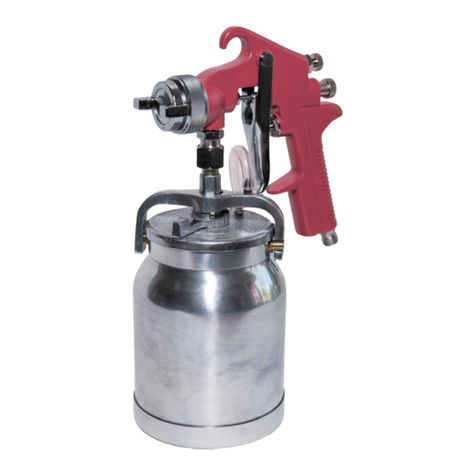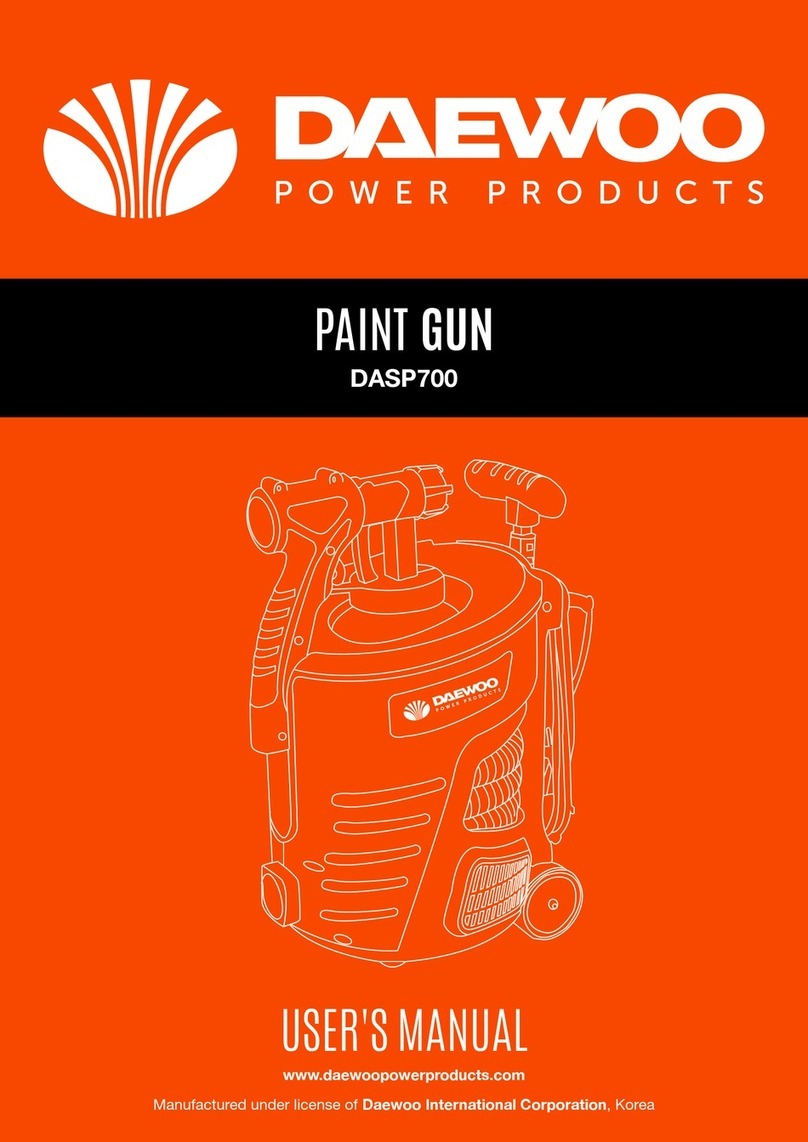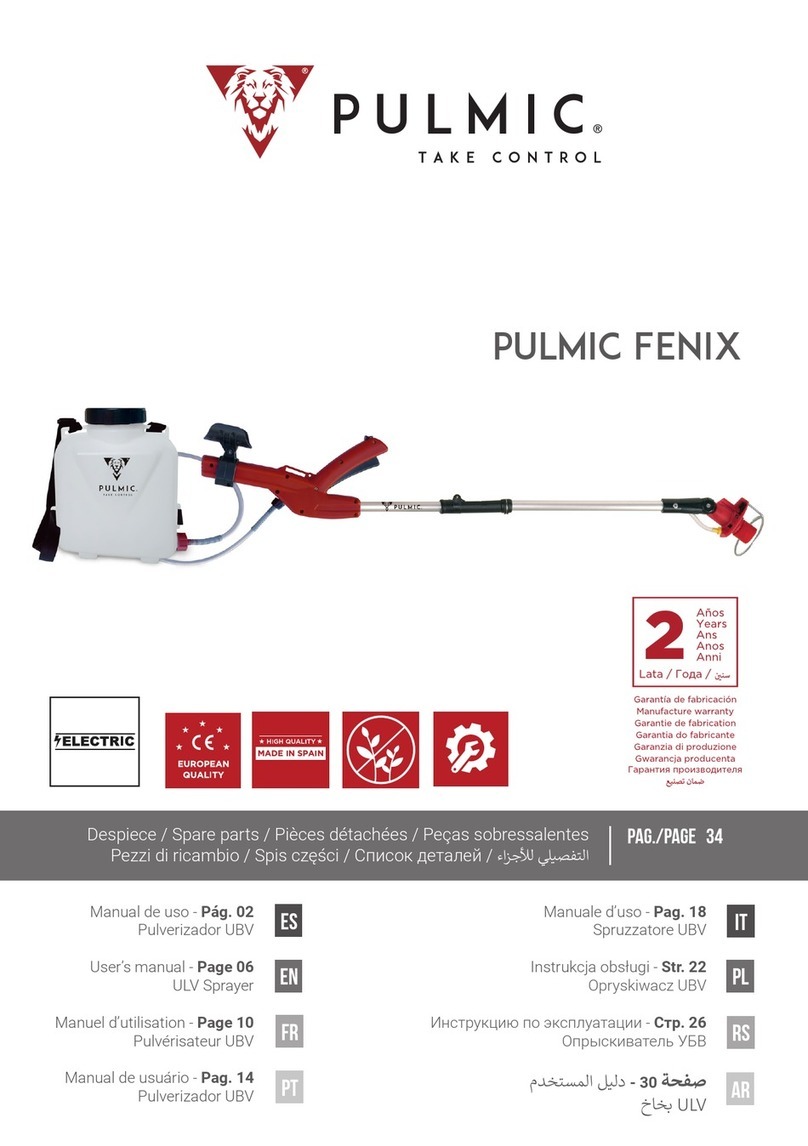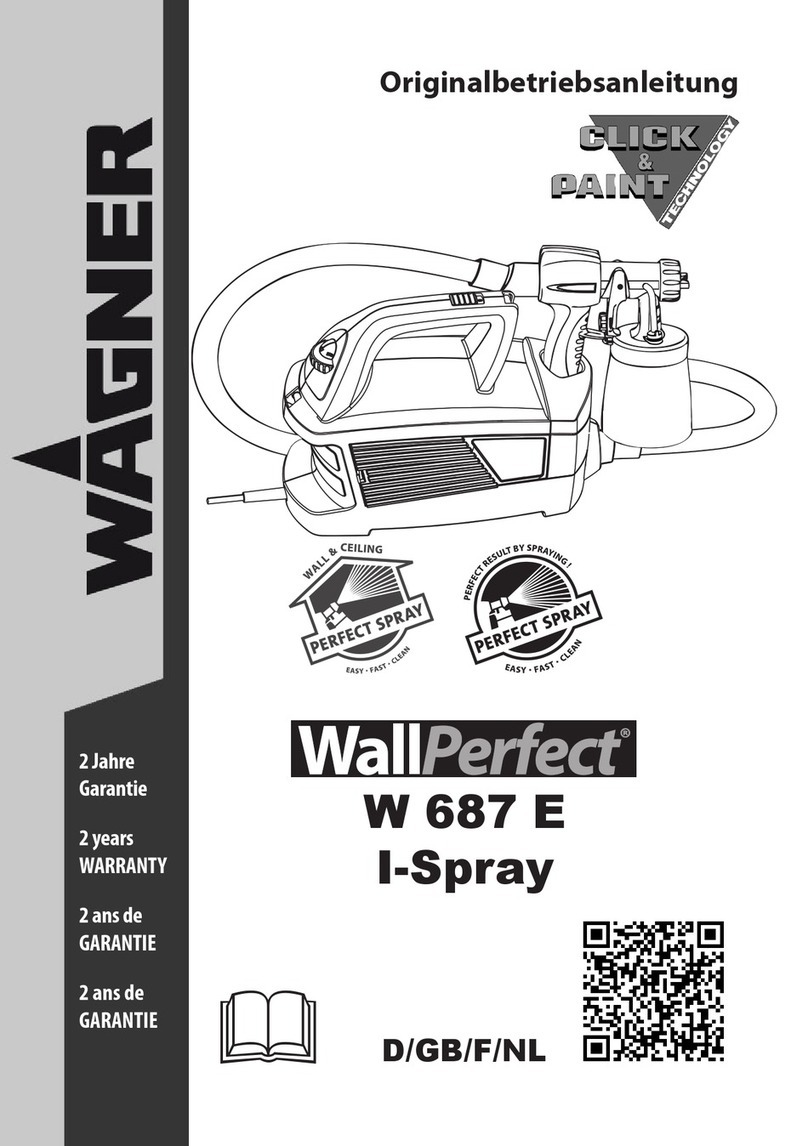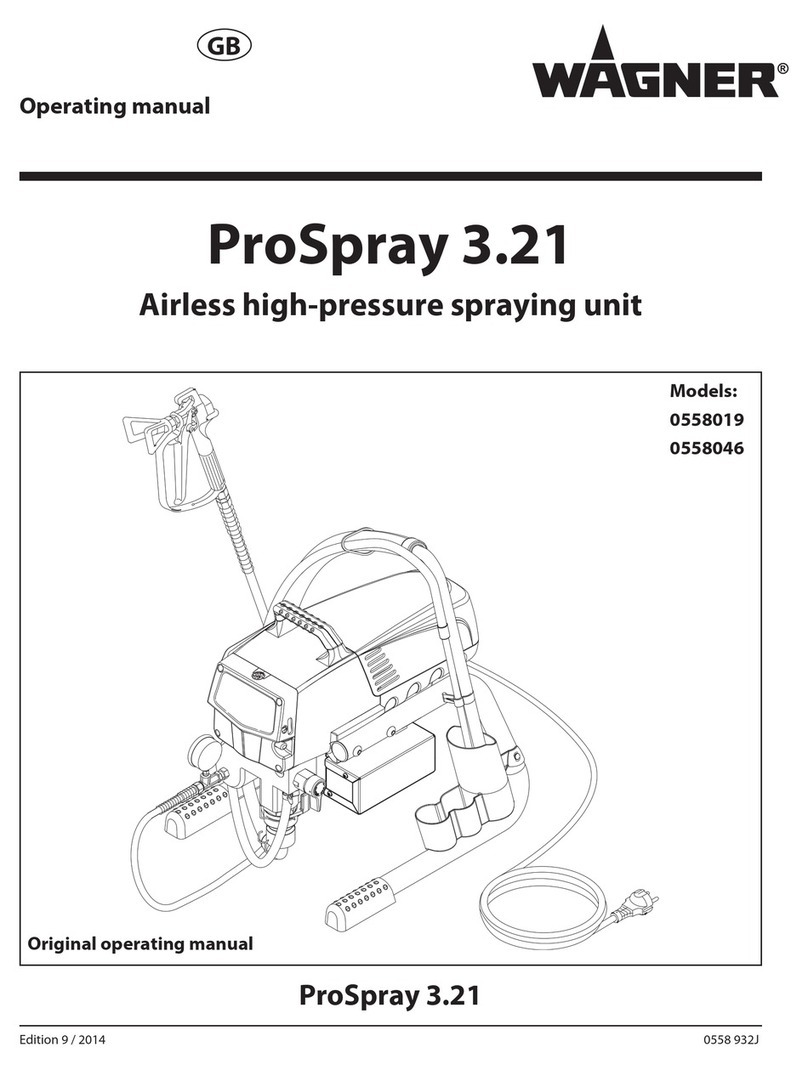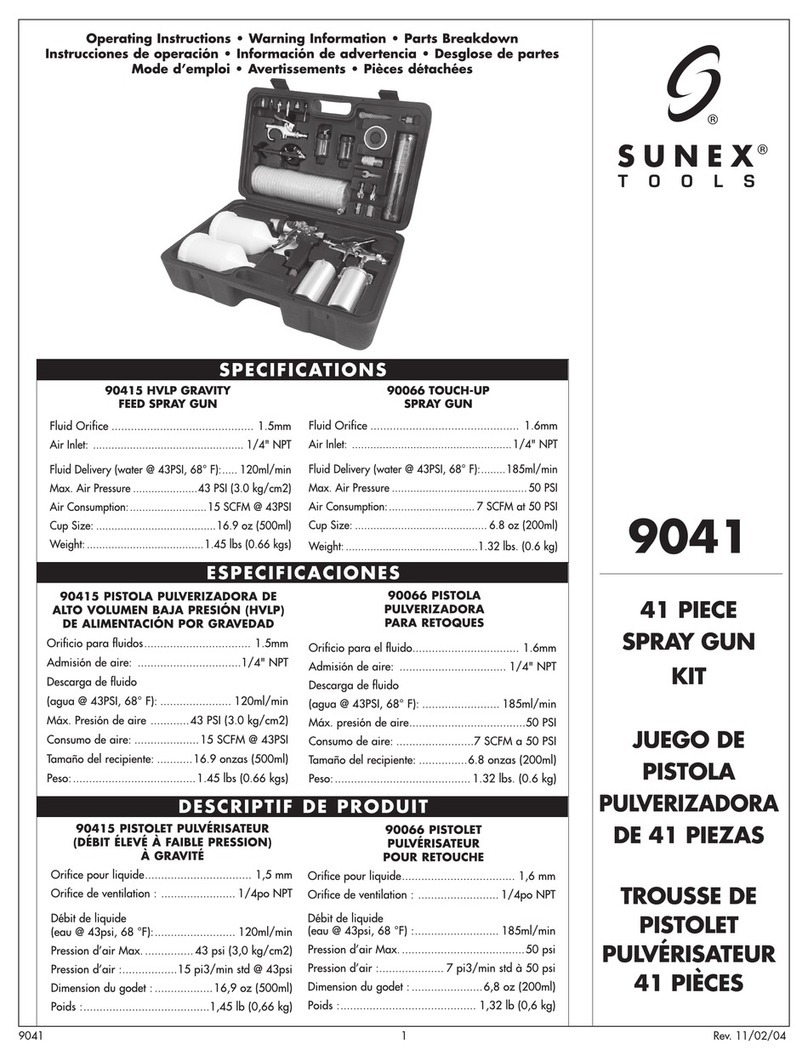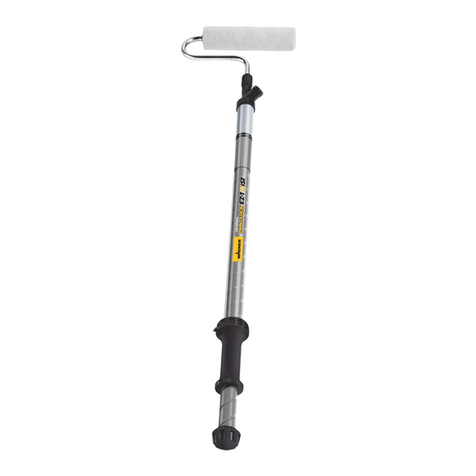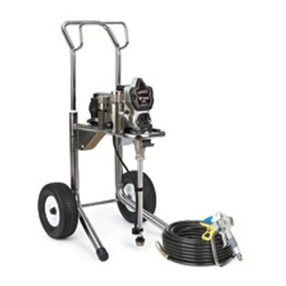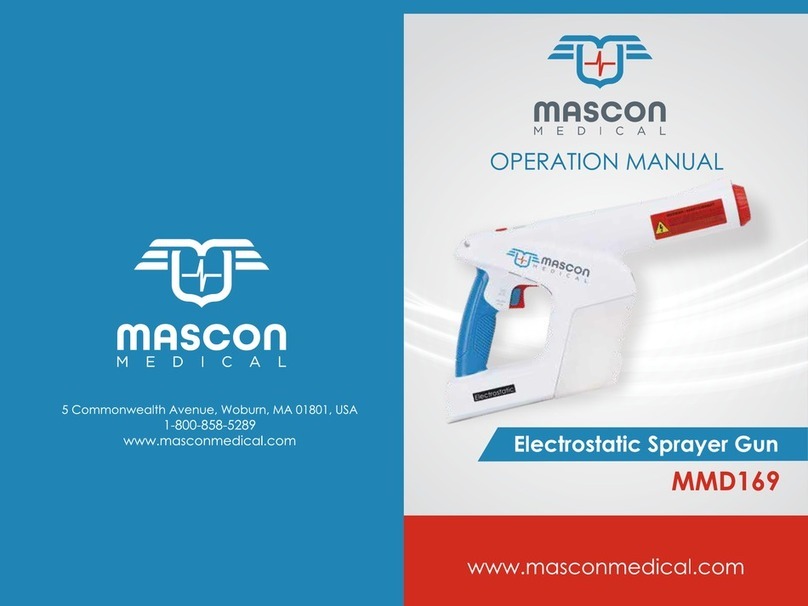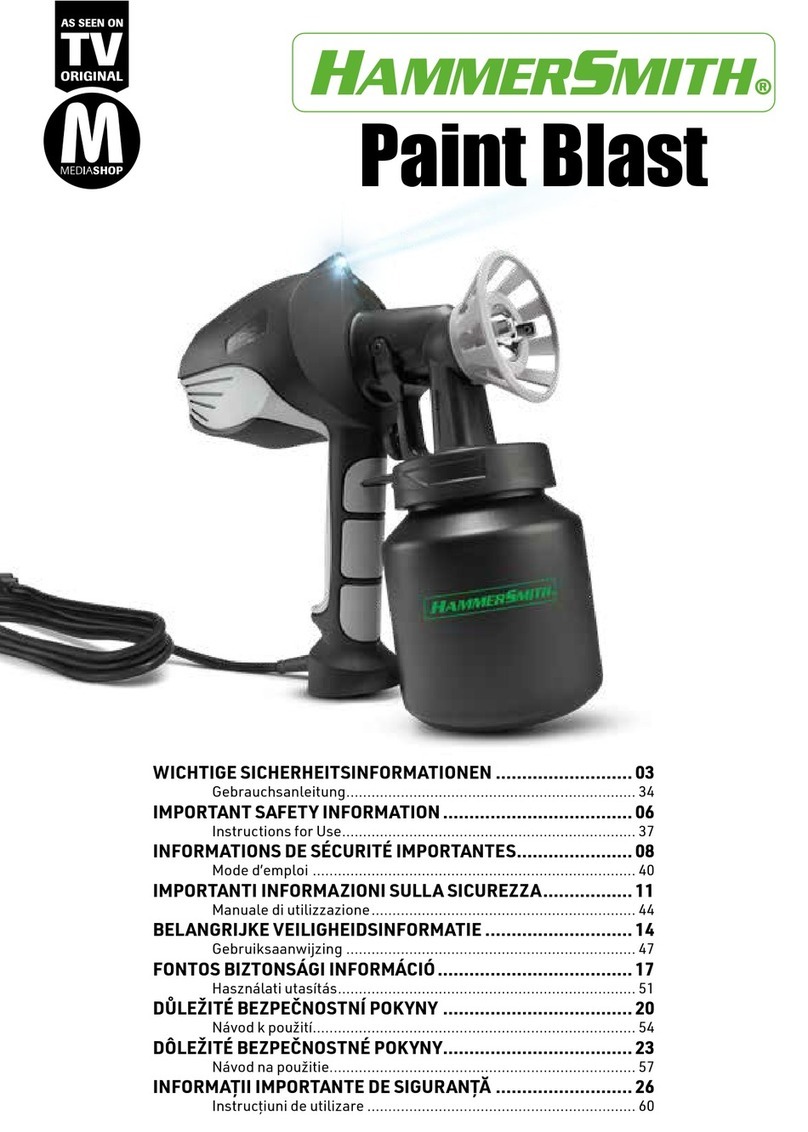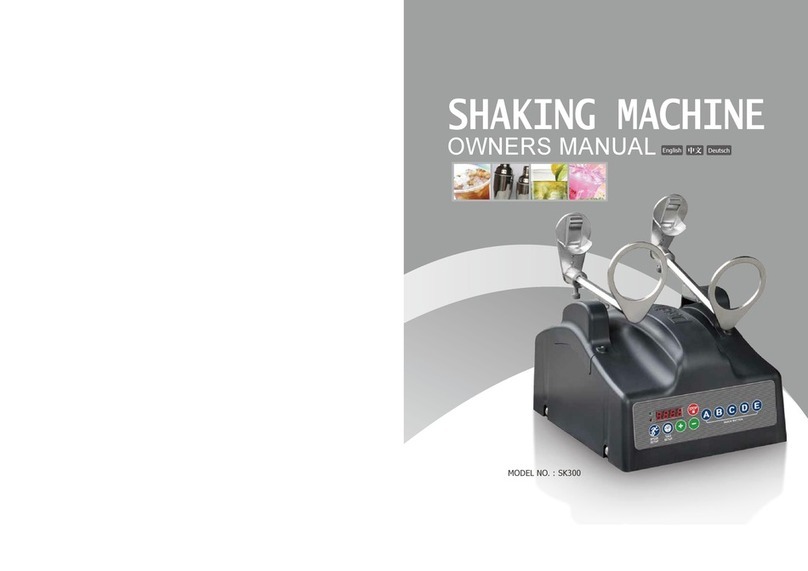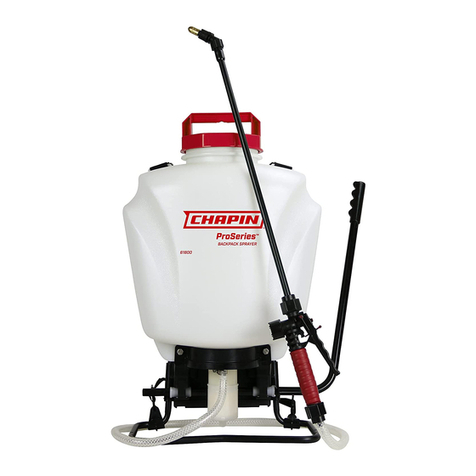Thunder H827C User manual

1
20 Fl. oz. High Volume,
Low Pressure Gravity
Feed Spray Gun
THIS MANUAL CONTAINS IMPORTANT INFORMATION REGARDING SAFETY, OPERATION, MAIN-
TENANCE AND STORAGE OF THIS PRODUCT. BEFORE USE, READ CAREFULLY AND UNDERSTAND
ALL CAUTIONS, WARNINGS, INSTRUCTIONS AND PRODUCT LABELS. FAILURE TO DO SO COULD
RESULT IN SERIOUS PERSONAL INJURY AND/OR PROPERTY DAMAGE.
IF YOU SHOULD HAVE ANY QUESTIONS OR EXPERIENCE A PROBLEM WITH YOUR RED THUNDER
PRODUCT, DO NOT RETURN THIS PRODUCT TO THE STORE. PLEASE CALL OUR CUSTOMER SER-
VICEDEPARTMENT AT 1-866-355-0018. BEFORE YOU CALL, HAVE THE FOLLOWING INFORMATION
AVAILABLE: MODEL No., DATE PURCHASED AND STORE LOCATION. AN RED THUNDER REPRE-
SENTATIVE CAN RESOLVE YOUR PROBLEM OVER THE PHONE. IF YOU WOULD LIKE TO MAKE A
YOUR FEEDBACK IS VITAL TO US.
MODEL: H827C
CLEAN IMMEDIATELY
Clean the spray gun IMMEDIATELY after EVERY
use, in between costs, and when it will be idle for
more than 5 minutes. Delay or inadequate cleaning
will permanently clog the spray gun.
NOTICE

2

This Spray Gun is designed for Household Use Only and is not intended for commercial
applications. It is well suited for do-it-yourselfers with a variety of home uses.
This instruction manual is intended for your benet. Please read and follow the safety,
installation, maintenance and troubleshooting steps described within to ensure your safety
and satisfaction. The contents of this instruction manual are based upon the latest prod-
uct information available at the time of publication. The manufacturer reserves the right to
make product changes at any time without notice.
INTRODUCTION
SAFTY ALERT
Read and understand this entire instruction manual
before attempting to assemble, install, operate or
maintain this Spray Gun.
Failure to comply with the instructions may result in serious personal injury and/or
property damage!
The safety instructions provided in this manual are not intended to cover all possible
conditions and practices that may occur when operating, maintaining and cleaning power
equipment.
Always use common sense and pay particular attention to all the DANGER,WARNING,
CAUTION and NOTE statements of this manual.
SAVE THESE INSTRUCTIONS FOR FUTURE REFERENCE
RECOGNIZE SAFETY SYMBOLS, WORDS AND LABELS
CONGRATULATIONS!
Thanks for choosing this product. At Red Thunder, our aim is to provide you with quality
products at an affordable price, and we want you to be totally satised with your product
and our Customer Service. If any help and advice is needed, please contact us at
1-866-355-0018. Properly cared for, this product will give you many years of satisfac-
tion.
DESCRIPTION:
HVLP (High volume low pressure) spray gun supply 10 psi low pressure through the air
cap which make the spraying softer, easily controlled and less overspray in high transfer
efciency. Includes adjustable uid, pattern and air controls. Designed to provide equal
atomization and particle size for all kinds of surface painting. Stainless steel needle and
nozzle accommodate a variety of coatings. Precise air cap set. Lightweight, ergonomic
design and easy trigger pivot reduce operating fatigue.
3

4
This is the safety alert symbol. It is used to alert you to
potential personal injury hazards. Obey all safety mes-
sages that follow this symbol to avoid possible injury or
death.
DANGER indicates an imminently hazardous situation
which, if not avoided, will result in death or serious injury.
WARNING indicates a potentially hazardous situation
which, if not avoided, could result in death or serious
injury.
CAUTION indicates a potentially hazardous situation
which, if not avoided, may result in minor or moderate
injury.
CAUTION used without the safety alert symbol indicates
a potentially hazardous situation which, if not avoided,
may result in property damage.
NOTE provides additional information that is useful for
proper use and maintenance of this tool. If a NOTE is
indicated make sure it is fully understood
NOTE
IMPORTANT SAFEGUARDS
Some dust created by spraying, blowing, power sanding, sawing, grind-
ing, drilling and other construction activities contains chemicals known
to the State of California to cause cancer, birth defects or other repro-
ductive harm. Reduce your exposure to these chemicals by wearing approved safe-
ty equipment such as dust masks that are designed to lter out microscopic particles.
Use of this product will expose you to chemicals known to the State of California to
cause cancer, birth defects, and reproductive harm. AVOID INHALING VAPORS
AND DUST. WASH HANDS AFTER USING.
UNPACKING & INSPECTION
After opening the carton, unpack your new Spray Gun and related parts & accessories.
Please inspect it carefully for any damage that may have occurred during transit. Please
check it against the photograph on carton. If any parts are missing, please contact our via
E-Mail: info@redthunderstore.com.

5
Do not operate this Spray Gun if damaged during
shipment, handling or misuse. Damage may result in
bursting, which can cause serious injury or property
damage. All damaged parts must be repaired or replaced as needed
prior to operating this Spray Gun.
Check to see that all nuts, bolts and ttings are secure before putting this Spray Gun
into service. If you have any questions, or require assistance with damaged or missing
parts, please contact our Consumer Helpline:
Phone: 1-866-355-0018
E-Mail: info@redthunderstore.com
SAFETY WARNINGS
READ ALL SAFETY WARNINGS BEFORE
USING SPRAY GUN
GENERAL SAFETY WARNINGS
Keep work area clean. Messy areas and cluttered workbenches invite personal
injury and/or property damage.
Keep children and visitors away. All children should be kept away from the work
area. DO NOT let children handle the compressor or extension cord. Maintain a safe
distance for any person near the work area.
Operating any tools or equipment under the inuence of drugs, alcohol,
or medication can cause personal injury to yourself and others.
Wear proper apparel. Remove your jewelry before using this tool. Do not wear
loose clothing, necklaces, rings, bracelets, or other jewelry, which may get caught
in moving parts. Nonskid footwear and electrically non-conductive gloves are highly
suggested while working. Wear protective hair covering to contain long hair.
Protect your eyes. The operation of this tool can result in foreign objects
being thrown into the eyes, which can result in severe eye damage.
Always wear eye protection that meets ANSI Z28.1 specications during
tool operation. Eyeglasses are not always safety glasses.
Be responsible for your hearing. Wear hearing protection during extended periods of
operation.
Be responsible for your hearing. Wear hearing protection during extended
periods of operation.

6
Use the right tool. Use tools properly and for their intended task. Do not
force a small tool to do the job of a heavy-duty tool. Using the right tool to do the right
job will make doing the job safer.
Check damaged parts before use of any air tools or attachments. A
guard or other part that is damaged should be carefully checked to ensure that it will
operate properly and perform its intended function. Check for misalignment or binding
of moving parts, breakage of parts, mounting, or any other conditions that may affect
tool operation. A guard or other part that is damaged should be properly replaced. See
replacement parts list for additional details.
Do not overreach. Proper footing and balance is a must at all times while using
tools. Unstable support may lead to personal injury. Slipping, tripping and falling can be
a major cause of serious injury or death. Be aware of excess hose left on the walking
or work surface.
When using air accessories, consult the owner’s manual provided by
the manufacturer.The use of improper accessories may cause risk of injury to
yourself and others.
Always make sure the tool is disconnected from air source when mak-
ing adjustments, changing parts, or performing any maintenance. Do not
abuse hoses or connectors.
Never carry tool by the hose or pull on it to disconnect from air source.
Keep hoses from heat, oil and sharp edges. Check hoses for weak or worn
condition before each use, making certain that all connections are secure.
Keep protective guards in place and in proper working condition.
Maintain tools and equipment with care. They will function better and more
safely when kept clean and in good working condition. Keeping the tool clean, dry, and
free of grime will add to its life and performance.
Childproof the workshop. The use of master switches and padlocks is highly
recommended. Remove starter keys where applicable.
SERVICE
Tool service must be performed only by qualied repair personnel. Ser-
vice or maintenance by unqualied personnel may result in a risk of injury.
When servicing a tool, use only identical replacement parts. Follow
instructions in the Maintenance section of this manual. Use of unauthorized
parts or failure to follow Maintenance Instructions may create a risk of electric shock or
injury.

7
SAFETY RULES FOR SPRAY GUNS
RISK TO BREATHING
• Spray materials may be harmful if inhaled, or if there is contact with the skin.
Adequate exhaust must be provided to keep the air free of accumulations of toxic
materials. For toxic vapors produced by spraying certain materials can create intoxica-
tion and serious damage to health. Always wear safety glasses, gloves and respirator
to prevent the toxic vapor hazard, solvent and pointing paint coming into contact your
eyes or skin.
• Operate the Spray Gun in a well-ventilated area. Read and follow all safety instruc-
tions for the material you are spraying. Be sure to use an approved respirator
designed for use with your specic application.
RISK OF FIRE OR EXPLOSION
• Avoid dangerous environments. Do not spray combustible/ammable liquid in a
conned area. Spray area must be well ventilated. Do not smoke while spraying or
spray where spark or ame is present. Do not use Spray Gun near gasoline or other
ammable materials. Operate the Spray Gun in a well-ventilated area. Never use
oxygen, combustible or other bottled gas as an air source. This could cause explosion
and serious personal injury. Fluid and solvent can be highly ammable or combustible.
Read and follow all safety instructions for the material
you are spraying. Be sure to use an approved respirator designed for use with your
specic application.
• Fire extinguishing equipment must be present in the spray area.
RISK OF INJURY
• Air under pressure can cause severe injury. Always shut off air supply, drain hose of
air pressure and disconnect tool from air supply when not in use and before chang-
ing accessories or when making repairs. Never direct air at yourself or anyone else.
Whipping hoses can cause serious injury. Always check for damaged or loose hoses
and ttings. Never use quick-change couplings at tool. They add weight and could fail
due to vibration. Instead, add a hose whip and connect coupling between air supply
and hose whip, between hose whip and leader hose whip, or between hose whip and
leader hose. Do not exceed MAXIMUM AIR PRESSURE. Use clean, dry and regu-
lated compressed air. Never exceed maximum permissive operating pressure. Always
use tool a safe distance from other people in work area.

8
• Maintain tools with care. Keep tools clean and oiled for best and safest performance.
Follow instructions for lubricating and changing accessories. Wiping or cleaning
rags and other ammable waste materials must be placed in a tightly closed metal
container and disposed of later in the proper fashion. Do not direct paint stream at
body. Use eye protection. Disconnect tool from air supply hose before doing tool
maintenance and during non-operation. For emergency stopping and prevention
of unintended operation, a ball valve near the gun to air supply is recommended.
• Repetitive work motions, awkward positions and exposure vibration can be harmful
to hands and arms.
RISK OF BURNS
Never use homogenated hydrocarbon solvent, which can chemically react with alumi-
num and zinc parts.
RISK OF FLYING OBJECTS
Do not direct paint stream at people or pets. During cleaning and ushing, solvents
can be forcefully expelled from uid and air passages. Some solvents can cause eye
injury. Be sure user and bystanders in the area are wearing impact resistant eye and
face protection. Even small projectiles can injure eyes and cause blindness. Before
operating the tool, make sure all the screws & caps are securely tightened in case
of leaking. Before painting, inspect the Spray Gun for free movement of trigger and
nozzle to insure tool can operate well. Never modify this tool for any other applications.
Only use parts, nozzles and accessories recommended by manufactures. The powerful
compressed paint stream can damage exposed skin and easily propel loose dirt and
other small objects at high-speed, resulting in serious injury. Always wear eye protec-
tion that meets ANSI Z28.1 specications. Never leave a Spray Gun unattended. Shut
OFF Spray Gun and relieve pressure before performing maintenance or repairs.
AIR TOOLS AND ACCESSORIES
Do not exceed the pressure rating of any air tools, spray guns, air accessories, or in-
atables. Excess pressure can cause them to explode, resulting in serious injury. Follow
the manufacturers recommended pressure settings for all air tools and air accessories.

9
INSTALLATION AND LOCATION
DO NOT place Spray Gun in an area:
• Where there is evidence of oil or gas leaks.
• Where ammable gas vapors or materials may be present.
• Where air temperatures fall below 32ºF or exceed 104ºF.
INSTALLATION AND LOCATION
CONTROLS AND
COMPONENTS:
1. Air Cap
2. Air Cap Nut
3. Cup Connector
4. Filter
5. Fluid Control Knob
6. Spray Pattern
Adjustment Knob
7. Cup Cover
8. Air Release Plug
9. Trigger
10. Air Volume Control
Knob
11. Air Inlet Coupling
12. Cup
13. Wrench
14. Socket Wrench
15. Brush
16. Extra Filter
OPERATION THE SPRAY GUN
Never aim or spray at yourself or anybody else which
would cause serious injury.

10
BEFORE SETUP
TO PREVENT SERIOUS INJURY FROM EXPLOSION:
Use only clean, dry, regulated, compressed air to power
this tool. Do not use oxygen, carbon dioxide, combustible gases, or any other
bottled gas as a power source for this tool.
1. Incorporate a lter, regulator with pressure gauge, in-line shutoff valve, and quick
coupler for best service, An in-line shutoff ball valve is an important
safety device becauseit controls the air supply even if the air hose is
ruptured. The shutoff valve should be a ball valve because it can be
closed quickly.
Note: Do not use an automatic oiler system or add oil to airline. The oil will con-
taminate the material being propelled, ruining the nal result.
2. Attach an air hose to the compressor’s air outlet.
3. Connect the air hose to the air inlet of the tool. Other components, such as a
coupler plug and quick coupler, will make operation more efcient, but are not
required.
WARNING! TO PREVENT SERIOUS INJURY FROM
ACCIDENTAL OPERATION:
Do not install a female quick coupler on the tool. Such
a coupler contains an air valve that will allow the air tool to retain pressure and
operate accidentally after the air supply is disconnected.
Note: Air ow, and therefore tool performance, can be hindered by undersized air
supply components.
4. The air hose must be long enough to reach the work area with enough
extra length to allow free movement while working.
5. Close the in-line shutoff valve between the compressor and the tool.
6. Turn on the air compressor according to the manufacturer’s directions and
allow it to build up pressure until it cycles off.
7. Open the in-line shutoff valve.
8. Adjust the air compressor’s output regulator so that the air output is enough
to properly power the tool, but the output will not exceed the tool’s maxi-
mum air pressure at any time. Adjust the pressure gradually, while checking
the air output gauge to set the right pressure range.
9. Inspect the air connections for leaks. Repair any leaks found.
10. If the tool will not be used at this time,turn off and detach the air supply and
safely discharge any residual air pressure to prevent accidental operation.

11
PREPARATION AND ASSEMBLY
1. After unpacking the product, inspect carefully for any damage that may have
occurred during transit. Make sure to tighten ttings, bolts, etc., before put-
ting unit into service. Tighten the gun to the cup securely using the connector
with lter inside.
2. Thoroughly mix and thin paint in accordance with the paint manufacturer’s
instructions. Most materials will spray readily if thinned properly.
3. Strain material through lter, cheese cloth or a paint strainer.
4. Tighten the gun to the cup securely using the connector with lter inside.
5. Fill the cup about 3/4 full and start the air compressor.
6. After connecting the gun to air supply, make sure that the Cup Cover, Cup
and Air Hose have been connected tightly with spray gun.
7. Set up a piece
of cardboard or
other scrap ma-
terial to use as a
target and adjust
for best spray
pattern.
CUP
CUP COVER
AIR
INLET
AIR HOSE
COMPRESSED
AIR
OIL AND
WATER
EXTRACTOR
To Air
Compressor
DO NOT EXCEED Maximum Pressure of Spray Gun
or any other parts in the compressor system.
Maximum pressure is 70 PSI. Consult with the paint
manufacturer for recommended air pressure.
Some Regulatory Agencies prohibit the operation of HVLP spray guns
above 10 PSI nozzle atomizing pressure.

12
AIR
INLET
AIR CAP
AIR VOLUME
CONTROL KNOB
PATTERN
ADJUSTMENT
KNOB
AIR CAP HORIZONTAL FAN
AIR CAP NUT
VERTICAL FAN
ADJUSTMENTS
• The direction of the fan (horizontal or
vertical) can be changed by loosening
the Air Cap Nut and turning the Air
Cap 90 degrees. Hand tighten Air
Cap Nut after adjustment.
• Amount of material released (density
of “fan spray”) is controlled by Fluid
Control Knob. Turn knob counter-
clockwise to increase, or clockwise to
decrease, the uid ow.
• Width of “fan spray” is governed by
Pattern Adjustment Knob. Turn
knob counterclockwise to increase,
or clockwise to decrease, air ow.
• Air quantity is controlled by Air
Volume Control Knob. Turn knob
counterclockwise to increase, or
clockwise to decrease, the air ow.
• Test the consistency of the material
by making a few strokes on a card-
board target. If material still appears
too thick, add a small amount of
thinner. THIN WITH CARE! Do not
exceed paint manufacturer’s thinning
recommendations.
OPERATION
1. Begin spraying. Always keep the gun perpendicular to the work.
2. Keep the nozzle about 6 to 12 inches from the work surface. Grip the gun per-
pendicular to the spraying area, then move it parallel several times. Stopping the
gun movement in mid-stroke will cause a build up of paint and result in runs. Do
not fan the gun from side to side while painting. This will cause a build up of paint
in the center of the stroke and insufcient coating at each end.
3. If spray is too ne, then decrease the air pressure or open uid control knob. If
the spray is too thick, then close the uid control knob. Regulate the pattern width
and repeat adjustment of spray as needed. Using the lowest possible atomizing air
pressure will reduce over-spray and provide maximum efciency.

13
4. Trigger the gun properly. Start the gun moving at the beginning of the stroke
BEFORE SQUEEZING THE TRIGGER and release the trigger BEFORE STOP-
PING GUN MOVEMENT at the end of the stroke. This procedure will blend each
stroke with the next without showing an overlap or unevenness. Spray pattern may
be innitely adjusted from round to at. The spray pattern of the gun is variable
from round to at with all patterns in between.
5. The amount of paint being applied can be varied by the speed of the stroke,
distance from the surface and adjustment of the uid control knob.
6. Overlap strokes just enough to obtain an even coat.
NOTE Two thin coats of paint will yield better results and have less
chance of runs than one heavy layer.
6-12 inches Coating should be even
and wet when spraying
Coating will be
light at this point
Coating will be too
heavy at this point
WRONG
RIGHT
7. Use a piece of cardboard as a shield to catch overspray at the edges of the work
to protect other surfaces.
MAINTENANCE
It shall be the tool owner’s responsibility to assure that tools are main-
tained in a safe operating condition. If tools are damaged, remove from service
immediately.
Tool repair shall be performed by authorized, trained, competent per-
sonnel. Please call our customer service at 1-866-355-0018 for information.
Tools shall be disconnected from their compressed air supply before
repair is attempted. Repairs shall be consistent with manufacturer’s recommended
procedures. Please refer to the Troubleshooting section.
Tools, hoses and ttings shall be replaced if unsuitable for safe opera-
tion.

14
Always exercise extreme care when using any solvent or thinner.
Never clean gun near re, ame, or any source of heat or sparks. Properly dispose of
used cleaning materials.
DO NOT soak entire spray gun in solvent or thinner for a long period of time as this
will destroy lubricants and possibly make motion uneven. NEVER use lye or caustic
alkaline solution for cleaning. Such solutions will attack aluminum alloy parts of gun.
It is important that spray gun be cleaned after daily use. Cleaning is accomplished
by spraying appropriate solvent or thinner through system. Wipe exterior of spray
gun with solvent soaked cloth or use cleaning brush(s) provided to remove any
accumulated material.
CLEANING
• Empty material from gravity feed cup and replace with a suitable solvent.
• Operate trigger until all material traces have disappeared and gun is thoroughly
clean.
• Remove Air Cap and clean with the provided cleaning brush.
IMPORTANT: Make certain air cap and uid nozzle are kept clean at all times.
If necessary, remove these two components (internal uid nozzle can be removed
using the provided wrench) and soak them in solvent. DO NOT use hard objects to
clean clogged holes. The smallest amount of damage may cause irregular spray
pattern.
NOTE If uid nozzle is to be removed for thorough cleaning,
squeeze trigger to prevent damage of uid needle tip when
unscrewing nozzle.
Lubrication procedures must be observed after thoroughly cleaning the gun to ensure
effective, high quality performance of spray gun.
1. Lubricate working points with straight mineral oil, or castor oil.
2. Periodically, place a few drops of oil on tapered sections of uid nozzle to ensure
easy operation of air cap. When spraying water base materials, coat uid nozzle
inside and outside with straight mineral oil after each use.
3. Outer diameter of needle sleeve of uid needle assembly must be lubricated
occasionally with straight mineral oil.
LUBRICATION

15
15
7
30
8
28
27
2
29
9
19
12
4
5
1
3
6
10 11 10
18
20
17
16
14
13
35
32
23
24 25 26
33
31
36
37
34
21
22
PART DESCRIPTION QTY
1 Nozzle 1
2 Lock Ring 1
3Ring Washer 1
4 Sealed Ring 1
5 Fluid Nozzle 1
6 Nozzle Seat 1
7 Nozzle Seat Gasket 1
8 Spacing Ring 1
9Screw Washer 1
10 Washer 2
11 O-Ring 1
12 Gun Body 1
13 Screw 1
14 Washer 1
15 O-Ring 1
16 Air-Valve 1
17 Valve Shaft 1
18 Valve Gasket 1
19 Switch Spring 1
20 Air Inlet 1
21 Adjust Nut 1
22 O-Ring 1
23 Needle 1
34 Needle Spring 1
25 Adjust Knob 1
26 Adjust knob Screw 1
27 Split Washer 2
28 Trigger 1
PART DESCRIPTION QTY
29 Trigger Pin 1
30 Needle Pin 1
31 Fluit Inlet Screw 1
32 Washer 1
33 Filter Connection 1
34 Connection Nut 1
35 Cup 1
36 Cup Lid 1
37 Vent Cap 1
Parts List and Diagram

16
SPECIFICATIONS
Air Pressure 20-70psi
Air Consumption 6CFM @40psi
Fluid Nozzle Size 1.4mm (0.057in.)
Feed Type Gravity
Mix Type External
Bleed Type Non-Bleeder
Air Inlet 1/4 In.-18 NPS
Cup Size 20 .oz (600ML)
SPECIFICATIONS

17
Note: The drawings on the left below resemble symptoms of spray pattern problems.Refer to the accompanying possible
causes and likely solutions to the right.
Troubleshooting - Spray Pattern Diagnosis
Problem Possible Causes Likely Solutions
Heavy center
pattern 1. Pattern Knob partially
closed.
2. The paint is too thick.
3. The air pressure is too low.
1. Open Pattern Knob more.
2. Thin paint according to the
manufacturer’s instructions.
3. Increase air pressure within
the Operating Air Pressure.
Light center
pattern 1. High air pressure.
2. Fluid Knob not open
enough.
3. Pattern Knob open too far.
1. Reduce air pressure.
2. Open Fluid Knob.
3. Partially close Pattern
Knob.
Heavy top/
bottom
pattern
1. Nozzle plugged.
2. Nozzle loose or dirty seal.
3. Dried paint on Fluid Tip.
4. Damaged Fluid Needle.
1. Clean Nozzle.
2. Clean and tighten Nozzle
and seal.
3. Use a nonmetallic point to
clean Fluid Tip.
4. Replace Fluid Needle and
Fluid Tip
Pattern on
right
or left only
1. Dirt on one side of Fluid
Tip.
2. Holes on one side of
Nozzle are plugged.
3. Damaged Fluid Needle.
1. Tighten or replace.
2. Rell paint Cup.
3. Backush with solvent.
4. Lubricate or tighten
Packing Nut.
Jerky or
Fluttering
Spray
1. Loose or damaged Nozzle.
2. Paint level low.
3. Obstruction in Fluid Inlet.
4. Dry or loose Fluid
Needle Packing Nut.
1. Tighten or replace.
2. Rell paint Cup.
3. Backush with solvent.
4. Lubricate or tighten
Packing Nut.
Follow all safety precautions whenever diagnosing or servicing the tool.
Disconnect air supply before service.

18
Possible Causes Likely Solutions
Sputtering Spray 1. Low paint level.
2. Cup tipped.
3. Clogged Air Vent on Cup.
4. Loose Fluid Inlet connection.
5. Loose/damaged Fluid Tip/Seat.
1. Rell.
2. Hold upright.
3. Clean Air Vent hole.
4. Tighten Fluid Inlet connection.
5. Adjust or replace Fluid Tip
and Fluid Needle.
Will Not Spray 1. High air pressure.
2. Fluid Knob not open enough.
3. Pattern Knob open too far.
1. Check air hoses.
2. Open Fluid Knob.
3. Thin uid or increase air
pressure.
(Do not exceed maximum.)
Overspray
(Paint drifting to
unintended
objects.)
1. Improper application speed.
2. Improper distance from
workpiece.
3. Too much air pressure.
1. Move moderately and parallel.
2. Adjust distance.
3. Reduce air pressure.
Fluid Tip Leakage 1. Dirty Fluid Tip.
2. Broken Fluid Needle Spring.
3. Worn or damaged Fluid Tip.
1. Use a nonmetallic point to clean
Fluid Tip.
2. Replace Fluid Needle Spring.
3. Replace Fluid Tip and Fluid
Needle..
Air Leaking from
Nozzle
1. Dirty Air Valve/Seat.
2. Sticking Air Valve.
3. Damaged Air Valve Spring.
4. Worn/damaged Air Valve/Seat.
5. Bent Air Valve Stem.
1. Clean Air Valve/Seat.
2. Lubricate Air Valve/Seat.
3. Replace Air Valve Spring.
4. Replace Air Valve assembly.
5. Replace Air Valve Stem.t.
Follow all safety precautions whenever diagnosing or servicing the tool.
Disconnect air supply before service.
General Troubleshooting Chart

19
LIMITED WARRANTY
WARRANTY STATEMENT
TO REQUEST WARRANTY SERVICE
This product is warranted to be free from defects in workmanship, materials, and com-
ponents for a period of one year from date of purchase. All parts and labor required to
repair defective products covered under the warranty will be at no charge. The following
restrictions apply:
1. The limited warranty applies to the original purchaser only.
2. The warranty applies to the product in normal usage situations only, as described in
this document. The product must be serviced and maintained as specied.
3. If the product fails, it will be repaired or replaced at the option of the manufacturer.
4. Transportation charges for warranty service will be reimbursed by the factory upon
verication of the warranty claim and submission of a freight bill for normal ground
service.
5. Warranty service claims are subject to authorized inspection for product defect(s).
6. The manufacturer shall not be responsible for any additional costs associated with a
product failure including, but not limited to, loss of work time, loss of refrigerant, and
unauthorized shipping and/or labor charges.
7. All warranty service claims must be made within the specied warranty period.
Proof-of-purchase date must be supplied to the manufacturer.
1. The sales receipt or other evidence of the date and place of purchase.
2. A description of the problem.
3. Delivery of the product or the defective part, postage prepaid and carefully packed
and insured, to:
Red Thunder, Inc
7683 SE 27th St, Suite 186
Mercer Island, WA 98040
1. Conditions, malfunctions or damage not resulting from defects in material or workmanship.
2. Conditions, malfunctions or damage resulting from normal wear and tear, improper installa-
tion, improper maintenance, misuse, abuse, negligence, accident or alteration.
3. Our limited warranties are void if a product is returned with removed, damaged or tampered
labels or any alterations (including removal of any component or external cover).
OUT OF WARRANTY

20
Red Thunder, Inc.
Address: 7683 SE 27TH Street, Suite 186
Mercer Island, WA 98040, USA
Phone: +1 (866) 355-0018
Email: info@redthunderstore.com
www.redthunderstore.com
Table of contents
Other Thunder Paint Sprayer manuals
Popular Paint Sprayer manuals by other brands
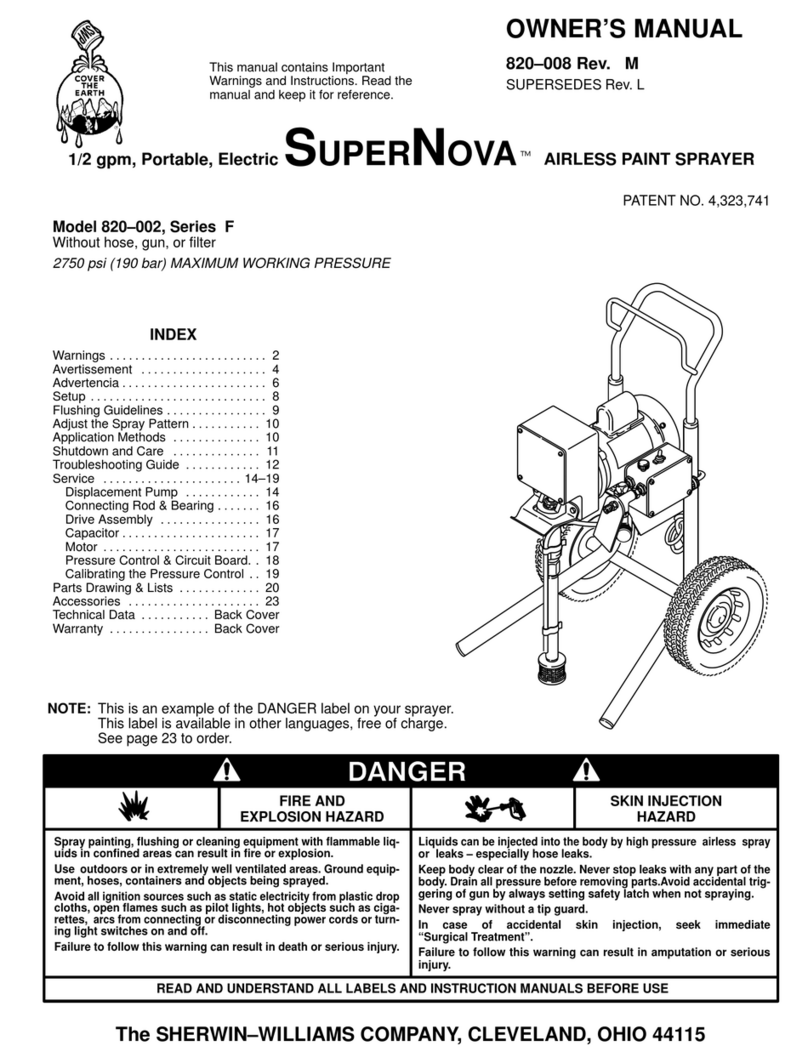
Sherwin-Williams
Sherwin-Williams SUPERNOVA 820-002 owner's manual
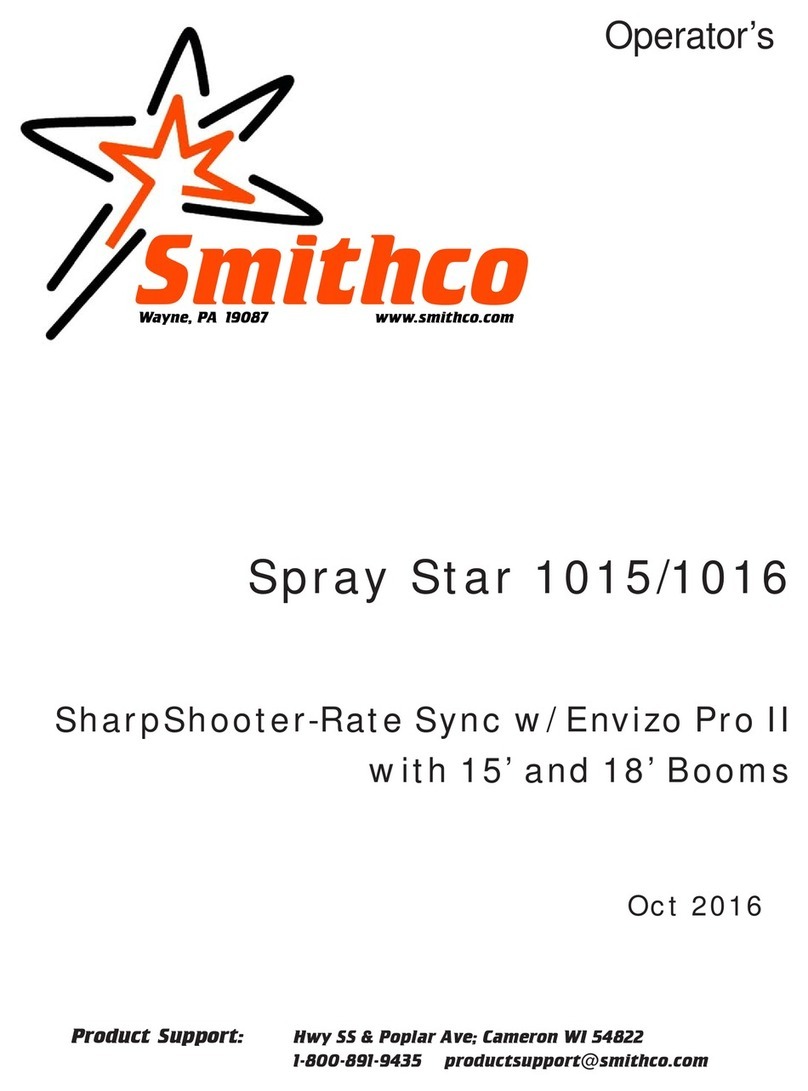
Smithco
Smithco Star 1015 Operator's
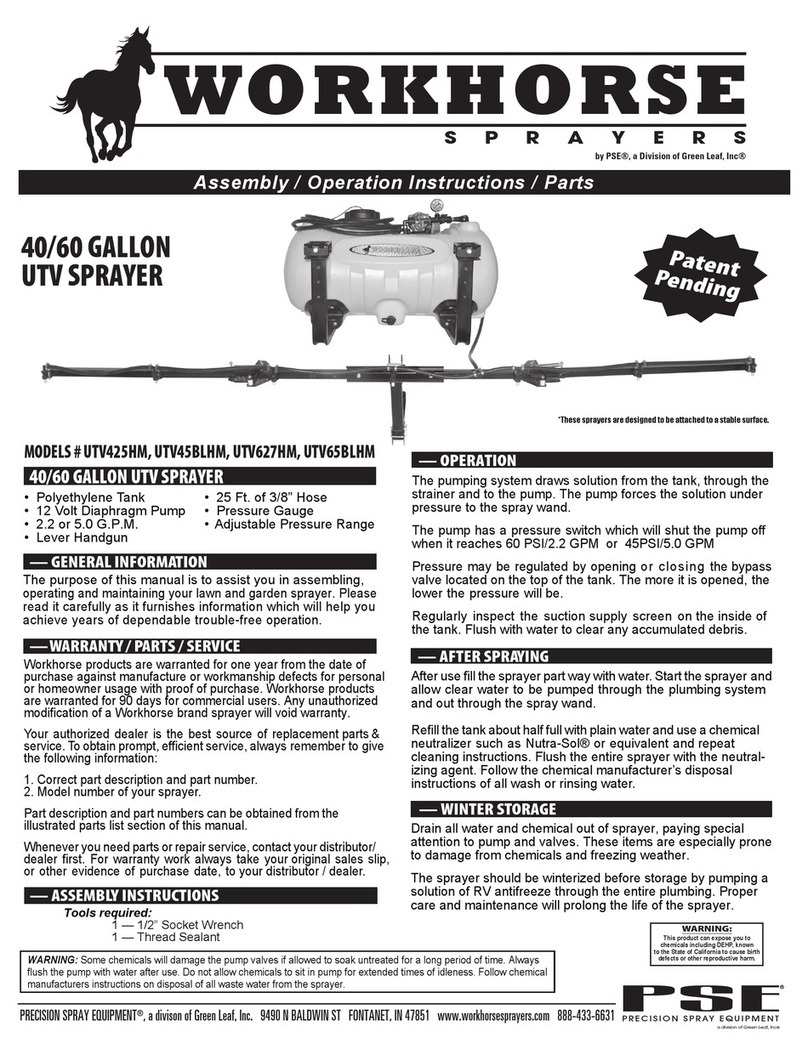
Workhorse
Workhorse UTV425HM Assembly / operation instructions / parts
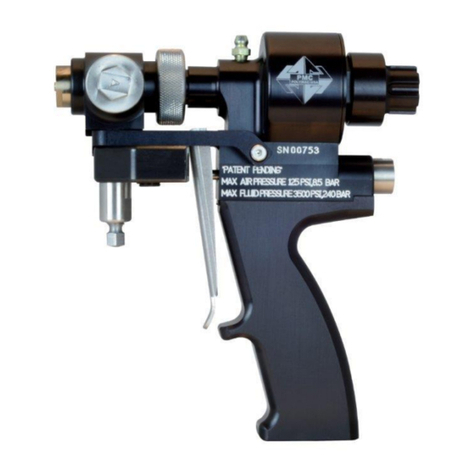
PMC
PMC AP-2 Service manual
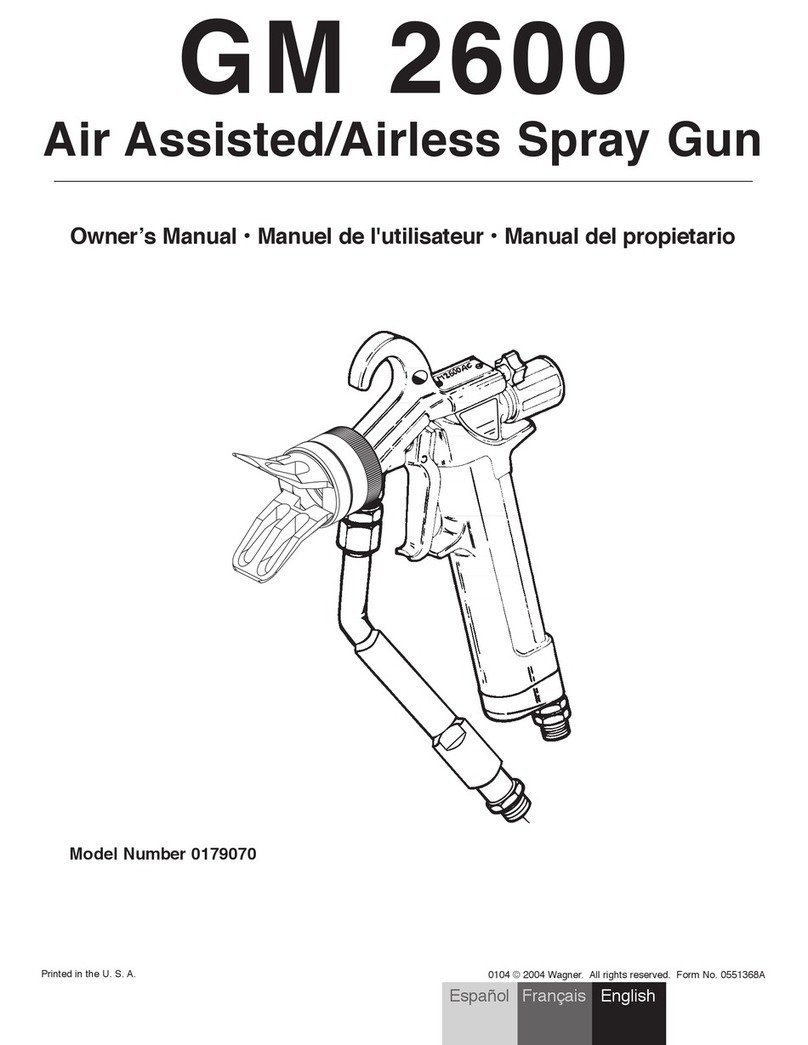
WAGNER
WAGNER GM 2600 0179070 owner's manual
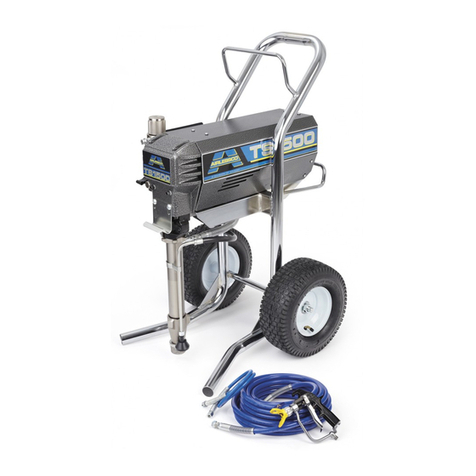
AIRLESSCO
AIRLESSCO TS1500 (24F573) B Series Operation - repair - parts
